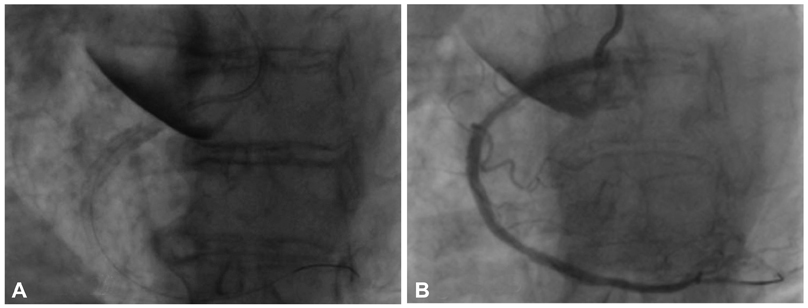Korean Circ J.
2012 Jul;42(7):504-506. 10.4070/kcj.2012.42.7.504.
Iatrogenic Bidirectional Dissection of the Right Coronary Artery and the Ascending Aorta: The Worst Nightmare for an Interventional Cardiologist
- Affiliations
-
- 1Department of Cardiology, CHU de Caen, Caen, France. ziad_dahdouh@hotmail.com
- 2Department of Thoracic and Cardiovascular Surgery, CHU de Caen, Caen, France.
- KMID: 2094125
- DOI: http://doi.org/10.4070/kcj.2012.42.7.504
Abstract
- Although rare, iatrogenic aortocoronary dissection is one of the complications most dreaded by the interventional cardiologist. If not managed promptly, it can have redoubted and serious consequences. Herein, we present the case of a 70 year-old woman who was treated by stenting of the second segment of the right coronary artery (RCA) for recurrent angina but, unfortunately, the procedure was complicated by anterograde dissection of the RCA with a simultaneous retrograde propagation to the proximal part of the ascending aorta. Successful stenting of the entry point was able to recuperate the RCA and to limit the retrograde propagation to the ascending aorta, but there was an extension of the dissection to the aortic valve leaflets resulting in a massive aortic insufficiency. Therefore, an isolated surgical aortic valve replacement was performed.
Figure
Cited by 1 articles
-
Computerized Tomography is an Effective Modality to Evaluate Iatrogenic Aortocoronary Dissection with Acute Myocardial Infarction
Seok In Lee, Chul-Hyun Park, Woong Chol Kang, Pyung Chun Oh
Korean Circ J. 2019;49(4):363-365. doi: 10.4070/kcj.2018.0284.
Reference
-
1. Akgul F, Batyraliev T, Besnili F, Karben Z. Emergency stenting of unprotected left main coronary artery after acute catheter-induced occlusive dissection. Tex Heart Inst J. 2006. 33:515–518.2. Wykrzykowska JJ, Carrozza J, Laham RJ. Aortocoronary dissection with acute left main artery occlusion: successful treatment with emergent stenting. J Invasive Cardiol. 2006. 18:E217–E220.3. Dunning DW, Kahn JK, Hawkins ET, O'Neill WW. Iatrogenic coronary artery dissections extending into and involving the aortic root. Catheter Cardiovasc Interv. 2000. 51:387–393.4. Al-Saif SM, Liu MW, Al-Mubarak N, Agrawal S, Dean LS. Percutaneous treatment of catheter-induced dissection of the left main coronary artery and adjacent aortic wall: a case report. Catheter Cardiovasc Interv. 2000. 49:86–89.5. Maiello L, La Marchesina U, Presbitero P, Faletra F. Iatrogenic aortic dissection during coronary intervention. Ital Heart J. 2003. 4:419–422.6. Yip HK, Wu CJ, Yeh KH, et al. Unusual complication of retrograde dissection to the coronary sinus of valsalva during percutaneous revascularization: a single-center experience and literature review. Chest. 2001. 119:493–501.
- Full Text Links
- Actions
-
Cited
- CITED
-
- Close
- Share
- Similar articles
-
- Erratum: Iatrogenic Bidirectional Dissection of the Right Coronary Artery and the Ascending Aorta: The Worst Nightmare for an Interventional Cardiologist
- Dual Fistulas of Ascending Aorta and Coronary Artery to Pulmonary Artery
- Wrapping of an Ascending Aortic Aneurysm with the Multiple Boot-Straps Technique in a Patient Undergoing Off-Pump Coronary Artery Bypass Grafting
- Total Arch Replacement with Stented Elephant Trunk in DeBakey Type I Acute Aortic Dissection
- Successful coronary stent retrieval from the ascending aorta using a gooseneck snare kit




